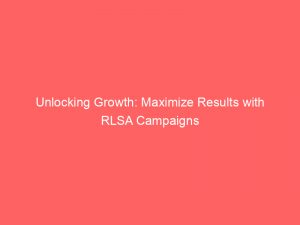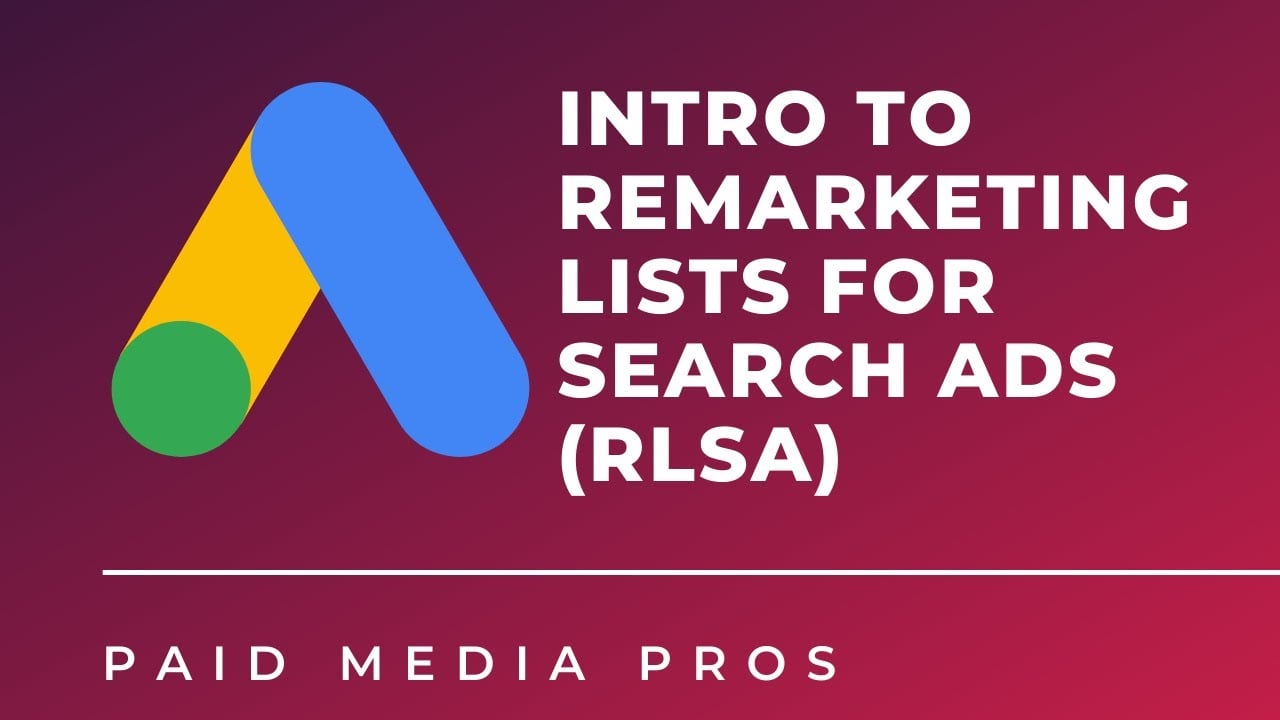In the competitive world of online marketing, grabbing the attention of customers is no easy task. But what if there was a way to target those who have already shown interest in your website?
Enter RLSA campaigns – a powerful tool that enables businesses to reach out to previous visitors and turn their curiosity into conversions. By using code snippets to create specific audiences, RLSA campaigns allow you to tailor your advertising to individuals who have already shown interest in your products or services.
In this article, we’ll explore the best practices for running a successful RLSA campaign and how it can help you drive more sales and grow your business.
rlsa campaigns
RLSA campaigns, also known as Remarketing Lists for Search Ads, are a valuable advertising strategy that allows businesses to target users who have previously visited their website. By adding a code snippet to their website, businesses can create specific RLSA audiences based on user actions.
These campaigns help businesses leverage interested audience members for increased conversions and efficient budget spending. To maximize the effectiveness of RLSA campaigns, it is important to understand the audience, create buyer personas and customer journey maps, and modify bids accordingly.
Upselling to converted users and bidding for broad terms can also yield significant benefits. Creating detailed customer journey maps helps generate leads and increase revenue.
RLSAs offer advantages such as increased sales and improved ROI. To implement RLSA campaigns, businesses must tag their site for remarketing and set up remarketing lists for search ad campaigns.
Segmenting audiences, tailoring ad copy for returning customers, and monitoring and growing audience size are essential tips for success. Researching keywords, bidding on broad terms, and making bid adjustments based on user behavior and demographics are also recommended strategies.
The use of remarketing lists helps segment audiences and create future personas.
Key Points:
- RLSA campaigns allow businesses to target users who have previously visited their website.
- Businesses can create specific RLSA audiences based on user actions by adding a code snippet to their website.
- RLSA campaigns help businesses increase conversions and optimize budget spending.
- Upselling to converted users and bidding for broad terms can benefit RLSA campaigns.
- Creating detailed customer journey maps can generate leads and increase revenue.
- Implementing RLSA campaigns requires tagging the site for remarketing and setting up remarketing lists for search ad campaigns.
Sources
https://neilpatel.com/blog/rlsa/
https://blog.hubspot.com/marketing/rsla-remarketing-lists-for-search-ads
https://www.wordstream.com/blog/ws/2015/03/12/remarketing-lists-for-search-ads
https://www.datafeedwatch.com/blog/rlsa-google-ads
Check this out:
? Pro Tips:
1. Implementing RLSA campaigns to target users who have previously visited the website is a strategic way to increase conversion rates and optimize budget spending.
2. Creating detailed customer journey maps can help identify potential leads and generate revenue through targeted RLSA campaigns.
3. It is important to carefully select which converted users should be retargeted, as not all converted users are worth bidding on.
4. Bidding on broad terms can be beneficial in RLSA campaigns, as it allows businesses to reach a wider audience and increase brand visibility.
5. Monitoring and growing the audience size of RLSA campaigns is crucial for continued success. Regularly analyzing data, researching keywords, and making bid adjustments based on user behavior and demographics will help optimize campaign performance.
What Are RLSA Campaigns And How Can They Benefit Businesses?
RLSA campaigns, which stands for Remarketing Lists for Search Ads, are a powerful tool that businesses can use to target users who have previously visited their website. By adding a snippet of code to their website, businesses can create specific RLSA audiences based on user actions.
This allows them to effectively reach out to individuals who have already shown interest in their products or services.
The benefits of RLSA campaigns are significant. By targeting a pre-qualified audience, businesses can increase their chances of conversions and maximize their return on investment.
Instead of spending their budget on reaching a broad audience, RLSA campaigns allow businesses to focus their efforts on those who are more likely to be interested in what they have to offer.
Key Takeaway: RLSA campaigns offer businesses the opportunity to target users who have previously visited their website, increasing the likelihood of conversions and optimizing budget spending.
Creating Specific RLSA Audiences Based On User Actions
To effectively utilize RLSA campaigns, businesses need to create specific audiences based on user actions. This can be done by setting up remarketing lists that capture user behavior on the website.
For example, businesses may want to create an audience of users who have added items to their shopping cart but didn’t complete the purchase.
Segmenting audiences based on various actions allows businesses to tailor their marketing efforts to the specific needs and interests of different groups. It also enables them to create buyer personas and customer journey maps, which are essential for understanding their target audience and crafting personalized messaging.
Key Takeaway: By creating specific RLSA audiences based on user actions, businesses can target different groups with personalized messaging and improve their understanding of their target audience.
Leveraging Interested Audience Members For Increased Conversions And Efficient Budget Spending
One of the primary advantages of RLSA campaigns is the ability to leverage interested audience members for increased conversions and efficient budget spending. By targeting users who have already visited their website, businesses can focus on individuals who are further along in the customer journey and more likely to convert.
To make the most of RLSA campaigns, businesses should consider modifying their bids. Bidding higher for users who have previously engaged with the website can increase the chances of conversions.
Similarly, bidding lower for users who have already converted can help ensure that budget is spent on attracting new customers.
Additionally, businesses must continuously monitor and grow their RLSA audience size. This can be done by regularly adding new remarketing lists and refining existing ones to engage with a larger pool of potential customers.
Key Takeaway: RLSA campaigns allow businesses to leverage interested audience members for increased conversions and efficient budget spending by modifying bids and continuously growing their RLSA audience size.
Best Practices For Successful RLSA Campaigns
To run successful RLSA campaigns, businesses should follow a set of best practices. These practices include understanding the audience, creating buyer personas and customer journey maps, and modifying bids based on user behavior and demographics.
Researching keywords and bidding on broad terms can also be beneficial for RLSA campaigns. This allows businesses to reach a wider audience and increase their chances of attracting new customers.
However, it’s important to note that not all converted users are worth retargeting. Businesses should carefully analyze their audience and focus their efforts on those who have the highest potential for repeat purchases or upselling.
Key Takeaway: Best practices for successful RLSA campaigns include understanding the audience, creating buyer personas and customer journey maps, modifying bids based on user behavior, and researching keywords and bidding on broad terms.
Matching User Actions And Upselling To Converted Users
One of the key strategies for effective RLSA campaigns is matching user actions and upselling to converted users. By analyzing user behavior on the website, businesses can identify opportunities for upselling or offering complementary products or services to those who have already made a purchase.
For example, if a user has purchased a smartphone, the business can use RLSA campaigns to target that user with ads for phone accessories or extended warranties. This strategy not only increases the chances of upselling but also enhances customer satisfaction and loyalty.
Key Takeaway: RLSA campaigns allow businesses to match user actions and upsell to converted users, thereby increasing revenue and enhancing customer loyalty.
Retargeting Strategies And The Benefits Of Bidding On Broad Terms
Retargeting is a crucial aspect of RLSA campaigns, but businesses need to be strategic in their approach. While it may be tempting to retarget all converted users, it’s important to remember that not all of them are worth retargeting.
By analyzing customer data and behavior, businesses can identify the most valuable segments to retarget and focus their efforts on those.
Bidding on broad terms can also be beneficial for RLSA campaigns. This allows businesses to capture a larger audience and increase their chances of attracting new customers who might be interested in their products or services.
However, it’s important to regularly monitor and refine the targeting to ensure that the campaign remains cost-effective and relevant.
Key Takeaway: Retargeting strategies in RLSA campaigns should be based on analyzing customer data to identify the most valuable segments, and bidding on broad terms can help attract new customers.
Utilizing Detailed Customer Journey Maps For Lead Generation And Revenue Increase
Detailed customer journey maps play a crucial role in the success of RLSA campaigns. By understanding the various touchpoints and interactions that potential customers have with their brand, businesses can identify opportunities for lead generation and revenue increase.
Customer journey maps help businesses visualize the paths customers take, allowing them to identify areas where they can improve the customer experience and increase conversion rates. Additionally, these maps enable businesses to tailor their messaging and advertising strategies to align with the specific needs and preferences of customers at each stage of the journey.
Key Takeaway: Utilizing detailed customer journey maps helps businesses generate leads, increase revenue, and improve the customer experience in RLSA campaigns.
In conclusion, RLSA campaigns offer businesses a powerful tool for targeting users who have previously visited their website. By creating specific audiences based on user actions, businesses can leverage interested audience members for increased conversions and efficient budget spending.
Following best practices, such as understanding the audience, modifying bids, and utilizing detailed customer journey maps, can maximize the results of RLSA campaigns and unlock growth for businesses.












